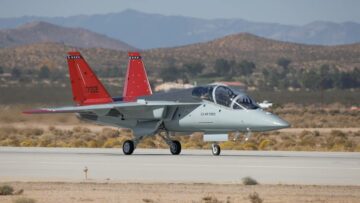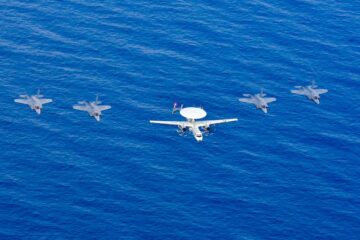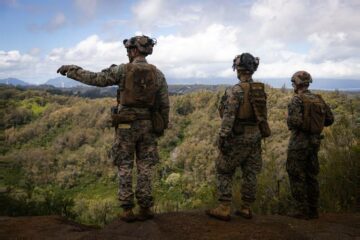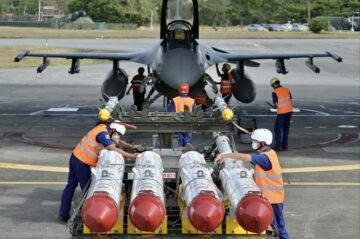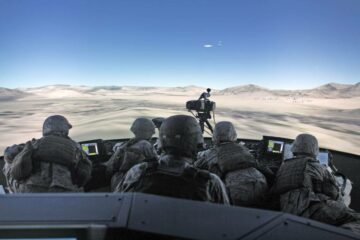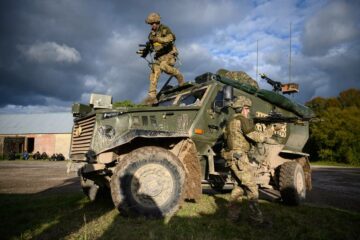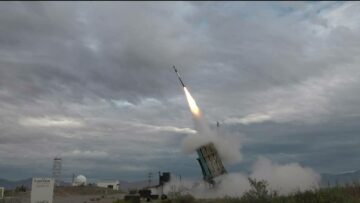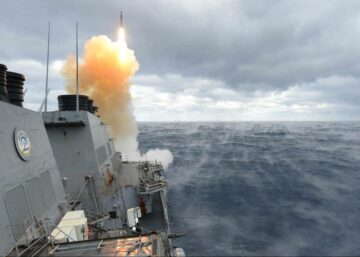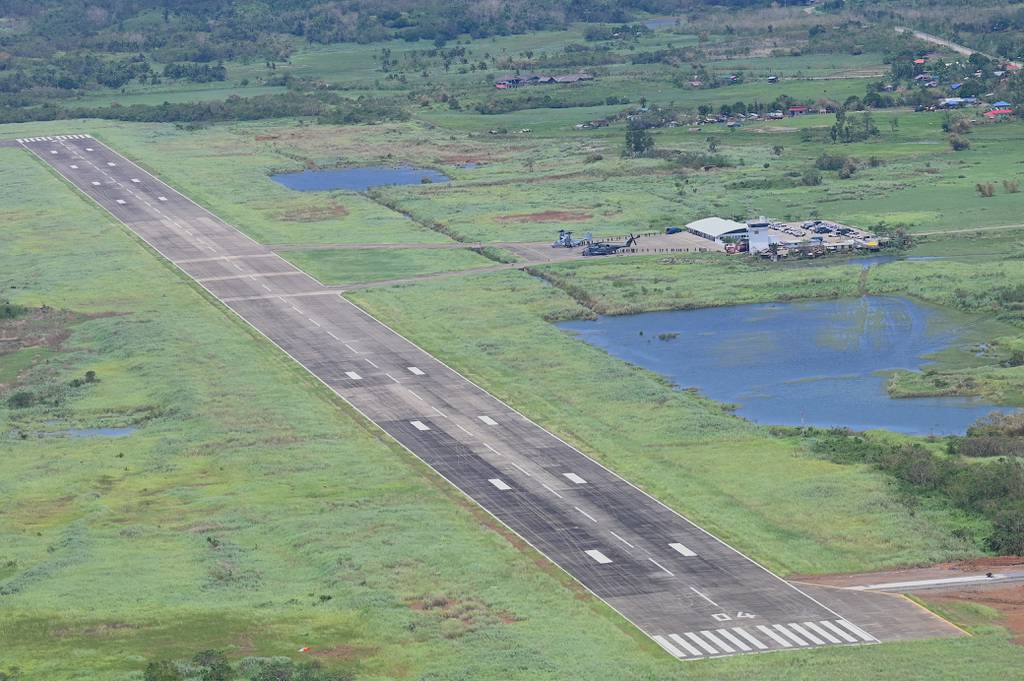
MANILA, Philippines — The Philippines is expected to work on dozens of projects this year to upgrade military bases as part of an agreement with the United States.
Signed in 2014, the Enhanced Defense Cooperation Agreement allows the U.S. to allocate funding to improve and construct facilities within existing Philippine military bases as well as to deploy American troops on a rotational basis.
For example, the Philippine government has proposed airstrip repairs for this year at Naval Base Camilo Osias, on the northern tip of the country’s island of Luzon, as part of the upgrade plans financed by the United States.
And some 42 miles southwest of the base, at Lal-Lo Airport, also in Cagayan province, the government is considering construction of a fuel storage facility and a command center.
The two countries identified five bases for the EDCA initiative in 2014, then added another four bases, including the two in Cagayan, in 2023. Notably, several of the newly accessible bases abut the South China Sea to the north.
China has decried some of the EDCA’s base locations due to their proximity to Taiwan, which Beijing considers a rogue province and has threatened to take back by force. Although the U.S. officially does not support Taiwan’s independence, Washington does provide it with weaponry, and U.S. President Joe Biden has promised to defend Taiwan in the event of a Chinese invasion.
“Whereas the U.S. claims that such cooperation is intended to help the disaster relief efforts of the Philippines and some Americans even tout the EDCA sites as [a] driver of [the] local economy, it is plain and simple that those moves are part of the U.S. efforts to [encircle] and contain China through its military alliance,” the Chinese government said in March. “To bundle the Philippines into the chariots of geopolitical strife will seriously harm Philippine national interests and endanger regional peace and stability.”
There’s also been local opposition. In 2022, provincial Gov. Manuel Mamba openly opposed the live-fire Balikatan exercise in the area, warning it could “anger” China and “bring war closer to the Philippines.”
The governor did not respond to Defense News’ request for comment.
Projects and price tags
Plans are already underway to fortify the newly accessible bases. This year will likely see Washington and Manila expand their cooperation and ready their respective navies to counter China’s assertions of ownership over parts of the South China Sea.
China and the Philippines, along with Vietnam, Malaysia, Brunei and Taiwan, have been locked in increasingly tense territorial disputes over the busy and resource-rich South China Sea. Washington lays no territorial claims to the strategically important waters but has deployed ships and aircraft for patrols that it says promote freedom of navigation and the rule of law. In turn, that military presence has infuriated Beijing.
At the announcement of the new basing deal in February, U.S. Defense Secretary Lloyd Austin thanked Philippine President Ferdinand Marcos Jr. for allowing the U.S. military to broaden its presence in the Philippines — Washington’s oldest treaty ally in Asia.
In a recent statement to Defense News, U.S. Indo-Pacific Command spokesperson Cmdr. Matthew Comer said the American government spent $56.8 million on the initial five EDCA sites from 2014 to 2023, during which it completed 14 projects.
But according Col. Medel Aguilar, who spoke to Defense News when he was the Philippine military’s spokesperson, the U.S. government provided nearly $82 million for 21 projects on those five bases from 2014 to 2022. Aguilar is now head of the armed forces’ civil relations office.
Indo-Pacific Command estimates 34 construction projects will begin this fiscal year, while the Philippine military has identified 14, including the construction or rehabilitation of multiuse facilities, piers, airports, warehouses, vertical landing pads, barracks and riprap.
“Our focus is on the 9 existing sites and the continued deliberative process with the Philippines to determine future requirements,” Comer wrote in an email to Defense News. “EDCA is about Philippine military modernization, not about the positioning of U.S. military assets.”
Aguilar declined to discuss specific monetary figures for the projects, instead saying the budget is different for each base and depends on the proposed activity.
In August, the U.S. reportedly proposed building a port in Batanes province facing the Bashi Channel, located about 125 miles from Taiwan. In October, the Philippine Navy inaugurated a naval detachment on Mavulis Island, also in Batanes, “to uphold maritime law and order while safeguarding our maritime territories,” the service said in a statement.
But local foreign affairs expert Julio Amador III said the EDCA initiative should also involve preparations for an influx of refugees if a war breaks out in the region.
Amador was director general of the Philippine government’s Foreign Service Institute and has been involved in defense talks since 2012. He is now the founder and chief executive of the consultancy Amador Research Services.
The EDCA projects should not just focus on military needs, he told Defense News, but also “other areas like [whether] we have the capacity to house the refugees.”
Furthermore, he thinks the American side should reassess its focus.
“Sometimes when we meet the American interlocutors, they tell us Taiwan is the priority, [and we say] if that’s the case, then prepare to not have us,” Amador said.
Still, he explained, “nobody wants the Americans to leave because they know once the Americans leave, China will be more aggressive.”
Geoff Ziezulewicz with Navy Times and staff from The Associated Press contributed to this report.
Leilani Chavez is an Asia correspondent for Defense News. Her reporting expertise is in East Asian politics, development projects, environmental issues and security.
- SEO Powered Content & PR Distribution. Get Amplified Today.
- PlatoData.Network Vertical Generative Ai. Empower Yourself. Access Here.
- PlatoAiStream. Web3 Intelligence. Knowledge Amplified. Access Here.
- PlatoESG. Carbon, CleanTech, Energy, Environment, Solar, Waste Management. Access Here.
- PlatoHealth. Biotech and Clinical Trials Intelligence. Access Here.
- Source: https://www.defensenews.com/global/asia-pacific/2024/02/05/whats-next-for-the-us-philippines-basing-agreement/
- :has
- :is
- :not
- 125
- 14
- 2%
- 2012
- 2014
- 2022
- 2023
- 21
- 34
- 4
- 42
- 70
- 8
- 9
- a
- About
- accessible
- According
- activity
- added
- Affairs
- aggressive
- Agreement
- aircraft
- airport
- Airports
- Alliance
- allocate
- Allowing
- allows
- Ally
- along
- already
- also
- Although
- amador
- American
- Americans
- an
- and
- Announcement
- Another
- ARE
- AREA
- areas
- armed
- AS
- asia
- asian
- Assets
- associated
- At
- Aug
- AUGUST
- austin
- back
- base
- basis
- BE
- because
- been
- begin
- Beijing
- biden
- boxes
- breaks
- broaden
- budget
- Building
- Bundle
- busy
- but
- by
- Capacity
- case
- Center
- Channel
- chief
- Chief Executive
- China
- Chinas
- chinese
- civil
- claims
- closer
- comment
- Completed
- considering
- considers
- construct
- construction
- consultancy
- contain
- continued
- contributed
- cooperation
- could
- Counter
- countries
- country’s
- deal
- defend
- Defense
- depends
- deploy
- deployed
- Determine
- Development
- DID
- different
- Director
- disaster
- Disaster Relief
- discuss
- disputes
- does
- driver
- due
- during
- each
- East
- economy
- efforts
- enhanced
- environmental
- EPA
- estimates
- Even
- Event
- example
- executive
- Exercise
- existing
- Expand
- expected
- expert
- expertise
- explained
- facilities
- Facility
- facing
- February
- Ferdinand Marcos Jr.
- Figures
- financed
- Fiscal
- five
- Focus
- For
- Force
- foreign
- fortify
- founder
- four
- Freedom
- from
- Fuel
- funding
- future
- General
- geopolitical
- goods
- Government
- Governor
- harm
- Have
- he
- head
- help
- her
- House
- HTTPS
- identified
- if
- iii
- images
- important
- improve
- in
- Including
- increasingly
- independence
- influx
- initial
- Initiative
- instead
- Institute
- intended
- interests
- into
- invasion
- involve
- involved
- island
- issues
- IT
- ITS
- joe
- Joe Biden
- jpg
- just
- Know
- landing
- Law
- Lays
- Leave
- like
- likely
- load
- local
- located
- locations
- locked
- Malaysia
- Manila
- manuel
- March
- Maritime
- matthew
- Meet
- Military
- million
- modernization
- Monetary
- more
- moves
- multiuse
- National
- Navigation
- nearly
- needs
- New
- newly
- news
- next
- no
- North
- notably
- now
- october
- of
- Office
- Officially
- oldest
- on
- once
- openly
- opposed
- opposition
- or
- order
- our
- out
- over
- ownership
- part
- parts
- peace
- Personnel
- Philippine
- Philippines
- Plain
- plans
- plato
- Plato Data Intelligence
- PlatoData
- politics
- positioning
- Prepare
- presence
- president
- president joe biden
- press
- price
- priority
- process
- projects
- promised
- promote
- proposed
- provide
- provided
- Provincial
- ready
- recent
- refugees
- region
- regional
- rehabilitation
- relations
- relief
- repairs
- report
- Reporting
- request
- Requirements
- research
- Research Services
- respective
- Respond
- Reuters
- Rule
- s
- safeguarding
- Said
- say
- saying
- says
- SEA
- secretary
- security
- see
- seriously
- service
- Services
- several
- ships
- should
- side
- Simple
- since
- Sites
- some
- South
- specific
- spent
- spokesperson
- Stability
- Staff
- Statement
- States
- storage
- Strategically
- such
- support
- Taiwan
- Take
- Talks
- tell
- territories
- that
- The
- The Area
- The Philippines
- The Projects
- their
- then
- they
- Thinks
- this
- this year
- those
- Through
- times
- tip
- to
- told
- TURN
- two
- u.s.
- U.S. government
- Underway
- United
- United States
- upgrade
- Uphold
- us
- vertical
- victims
- Vietnam
- wants
- war
- warning
- was
- washington
- Waters
- we
- WELL
- when
- whether
- which
- while
- WHO
- will
- with
- within
- Work
- wrote
- year
- zephyrnet


